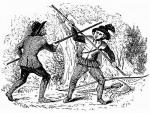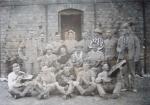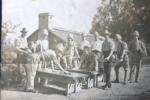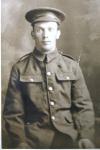-
Posts
13,225 -
Joined
-
Last visited
-
Days Won
22
Content Type
Profiles
Forums
Blogs
Gallery
Events
Store
Everything posted by Mervyn Mitton
-
Michael - also, welcome to GMIC. Simon, I'm so pleased you said first that you wern't certain about this wing - I was thinking was it another name for the 'upward' wings of the SAS ? Now that I have seen a picture from your link I can recall seeing it before, but it is certainly quite rare. Probably only Leigh would have known at once.....
-

What is a Shot Bucket?
Mervyn Mitton replied to VtwinVince's topic in Great Britain: Militaria: Badges, Uniforms & Equipment
You may be lucky and have a genuine one - you will need to show a picture for us to see the Royal Arms. The arms will date it to periods and also, if it is genuine they will be hand painted - copies will be transfers. Thousands of copies of these buckets are being made in India and Pakistan and sold to the West. -
Craig - I missed these before - nice souvenirs and attractive designs. Pity about the Kepi though ! Ed - why don't you try about 10 to a picture - and show a few at a time ? I don't know much about space - but, why not ask Nick .
-
This transitional period must have been very short - the Bow Street Constables in 1810 had truncheons similar to the later style. The ones shown here all date from around the 1850's - and are heraldically painted. By about 1880 they stopped the painting. On the left a County pattern - middle, a Town Truncheon and on the right, a Special Constable's truncheon.
-
So - how did the staffs of a previous year - which had no handgrips - come to change shape. There is no published order that we know of - just a natural progression to a simpler and easier weapon. I was fortunate to buy - many years ago - one of the transitional truncheons. This came from the area of the New Forest in Hampshire in England and was probably from one of the big estates in the area. Tipstaffs - which were separate from staves - had the job of showing the person's authority and power - this transitional speciman, is both a truncheon and a tipstaff. I can't really explain just how rare it is - one of my more treasured possessions - and only a collector will see it's historical importance. I suppose it dates from the 1780's - 1790's and it's quality immediately shows that it was to be carried by a Gentleman - probably a local magistrate. The III above the Crown are for George 3rd. - 1760 - 1820
-
This is a long staff for the Town of Hull - which is on the North Sea. Overall it is 5feet 4 inches long (165cm). The background is painted black and only at the top are there the decorations showing Royal Authority. On the reverse - shown here - is the Constable's number '20'. This will date from the early part of Queen Victoria's reign - about 1840. The Permissive Act of 1839 gave a choice to Towns to set-up a Force on the basis of the Metropolitan Police. Hull must have decided to wait for the Obligatory Act of the 1850's.
-
There are many items that we hear about - or, for that matter, come into contact with - but, which we know little about from the historical context. Truncheons would certainly come under that heading for most people - and why should they need to know more then that it is a defensive/offensive weapon carried by the Police. However, like many things, when you go into their background you find a wealth of interesting history - customs - and associations. The word Constable is held - by many - to come from the old Roman name 'Comes Stabulii' - or, Count of the Stables. He carried a staff - or Baton - to show his authority and this has followed down in history through many different ranks. The title is still used and The Queen appoints a Constable of the Tower of London - usually a retired high ranking officer. We are dealing here though with the Police connection - which in England can be traced back to early Saxon times - probably the 6 and 7th Century. The equivalent of a present day Magistrate's Court was the Folk Moot and this consisted of the 'Eldermen' of the settlement. Councils still appoint Aldermen as a mark of distinction. I have said many times - very few Countries have such an unbroken line of customs and expressions. Obviously, there was no official body of men at their disposal - although a 'head borough' or Tything Man could be appointed to carry out the wishes of the Community. Did he carry a truncheon ? The short answer is - No ! However, the weapon carried by everyone outside of Knights and their armed Sergeants, was a five to six foot long wooden staff(150cm-180cm) - known as a quarterstaff. Perhaps you have seen a Robin Hood film where 'Little John' defeats Robin on the wooden bridge, using such a staff ? These were not to be taken lightly - they were quite capable of killing or, maiming an opponent and because they were in regular use, the users were experts. King Richard 1st. introduced a system of Magistrates in the 12th.Century and it is thought that at that time they each had a small body of men carrying these staves and that they were probably painted at the top part to show Royal Authority. We can't prove this - however, there are mentions in early writings. Decorated staffs (or,staves - a plurality word) continued as weapons and authority through the many layers of Parish Constables and Watchmen - and indeed right down to the early 1800's. Sometimes the full staff was considered unwieldly - and then it would be shortened to about 3 feet (90cm) and the decorated end was used. Notices of that time for calling out the Constables would often specify 'short' or 'long' staffs.
-

Shanghai Municipal Police - c1938 uniforms/arms
Mervyn Mitton replied to 1314's topic in Police Forces of the World
1314 - I will try to find the reference you give. You will remember the quite lengthy discussion we had some time ago, on Shanghai. We seem to have lost 'Shanghai Lil' - (I can't remember her name !) which is a pity as she was collecting the area. There were a number of other independent Territories off the Coast around there. I sold my Inspector's cap badge - a rare item. Have you located any other pieces ? Mervyn -

Anglo-German pair of medals
Mervyn Mitton replied to JBFloyd's topic in Great Britain: Orders, Gallantry, Campaign Medals
One of those rare groups that you hear about - but, never see outside of museums. The impressing of the SWA German medals never - to me at least - seems to be of a high definition and quality. I presume they were cast in Germany ? -

Unidentified Pictures
Mervyn Mitton replied to Mervyn Mitton's topic in Great Britain: Research, Documentation & History
Simon - you are quite right about the chevrons - thankyou. I think Peter could be right about the ribbon - but, always the possibility of the Sudan. I have tried Hugh's Ctrl and + , but it still is blurred. Looking at the envelope, does it say GNR. or. Gma (grandma) ? The younger one has no insignia at all. A rough looking bunch... -
Bob - a very nice sword - in excellent condition for it's age. The pattern was an 1820's made by the French and for many years they made and shipped them to the US. I think most of the later ones were made in the US. Because of the popularity of the sword - obviously associated with the Civil War - it is the most highly forged sword in the World ! India is the main producer, closely followed by Italy. The copies are so good that I will not buy them - the only positive way to tell is to put the point on the floor - and lean on it...... if the blade snaps it is a forgery - but sellers don't like you doing this ? I am sure you have good provenance - how long have you had it ?
-

E11R Diamond Jubilee 2012
Mervyn Mitton replied to bigjarofwasps's topic in Great Britain: Orders, Gallantry, Campaign Medals
IMHO a very attractive medal - and the face of the Queen has been nicely aged. I hope the British issue will be similar as Nick suggests. -

Unidentified Pictures
Mervyn Mitton replied to Mervyn Mitton's topic in Great Britain: Research, Documentation & History
-

Unidentified Pictures
Mervyn Mitton replied to Mervyn Mitton's topic in Great Britain: Research, Documentation & History
-

Unidentified Pictures
Mervyn Mitton replied to Mervyn Mitton's topic in Great Britain: Research, Documentation & History
-

Unidentified Pictures
Mervyn Mitton replied to Mervyn Mitton's topic in Great Britain: Research, Documentation & History
-

1877 Romanian War of Independance Turkish Bayonet.
Mervyn Mitton replied to Kev in Deva's topic in Swords & Edged Weapons
Kev - I'll have a look in the bayonet books as well. Hope you're going to take pictures for the Museum section - should be very interesting. Also, how about a few of the local Police uniforms and vehicles for foreign police sub-forum ? But don't get arrested as a 'spy'...
















